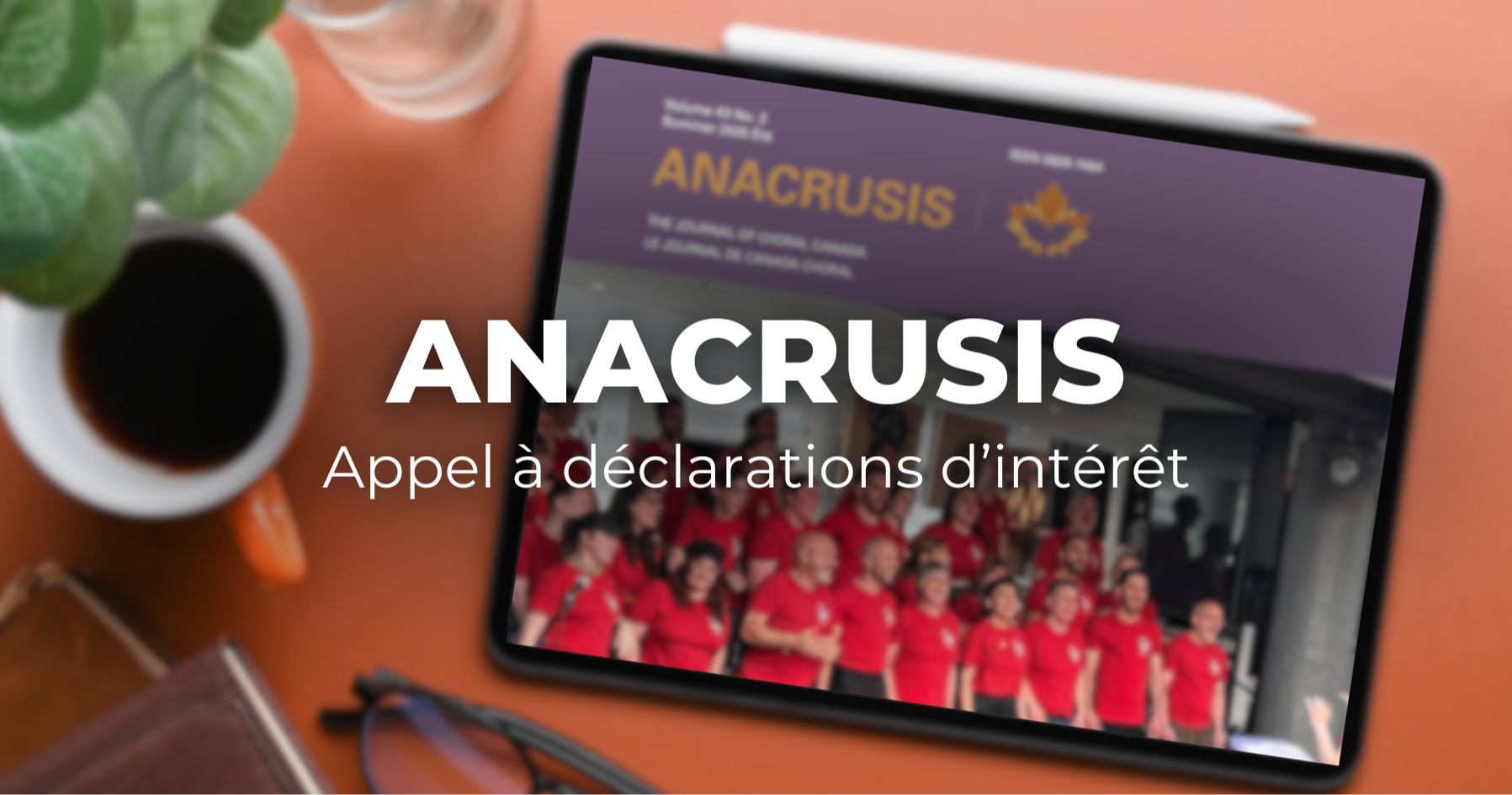Photo credit: Michael James, Halifax Camerata Singers
Guest post by Joan Fearnley
This guest post is an assessment of choral practices and their relevance to COVID-19 outbreaks. Data was collected using secondary sources such as media and scholarly reports of events, contemporary guidance from choral organisations or local public health regulations, and on testimonials (when other sources were not available). It does not constitute, however, advice on how to run your choir rehearsal. Please continue to stay up to date and follow all public health protocols applicable to your region.
From day one of the pandemic choral singing has carried the “superspreader” label following tragic events of viral transmission. But is this label still a fair one given everything we know today? Based on a review of 24 superspreader events in choirs I can only conclude that it is not a fair depiction when health protocols are followed including masking. I have determined that the superspreader events studied happened when singing was almost certainly NOT masked. Meanwhile I have not come across any outbreaks when masks were worn.
Choral singing in the pre-pandemic format is indeed a potential superspreader as are other activities where humans gather, mingle, talk loudly and sing. But over many months choirs and singing groups have adapted and implemented safety measures. Nevertheless, every media report and scholarly study begins with that infamous case which you all know and I dare not name (but here’s the link). Inevitably most reporters/researchers stop there as if trapped in an echo chamber. There is no nuance and no discussion of safety protocols.
This post is part of a broader discussion around the relative safety of choirs compared to other activities such as sports and indoor dining as regions emerge from their restrictions. While I am aware of the importance of this broader discussion, it is beyond the scope of this post. I hope others will take up this work.
I wish to acknowledge the tragic losses and pain related to these choral outbreaks. I also wish to recognize that in the vast majority of cases choral leadership was acting in good faith within the public health guidance in effect at the time. These efforts most likely avoided viral transmission. I am also by no means imputing blame of any kind on leadership for these outbreaks. Rather, I value the importance of learning from these events.
Finally, I wish to acknowledge the support of Choral Canada for providing the space on their blog to publish this research. I also wish to thank Sonja Greiner, Secretary General of the ECA, for her help as well as the help from friends and colleagues in the choral and mask-making community for links to information, for sharing their experience, and for helping me when the language barrier was a bit too complex.
This post will begin with a review of these 24 cases and will be followed by some discussion on viral transmission in the choral context.
Masking and Singing
There is an emerging body of evidence that masks are an effective layer of mitigation in the community at large (here) and for singers (here and here). However, it is not a magic bullet. Rather, it is one of a suite of mitigation strategies that must also be in place. We need to better understand viral spread in choirs to ensure safe rehearsals where risks are reasonably mitigated and masking can be a part of that solution. I focused on masks for the following reasons:
- First, asking whether masks were worn is a clear yes/no question; you either wear one or you don’t. Other mitigation measures are more subjective.
- Second, by summer 2020, choral organizations agreed on most safety measures such as distancing and hygiene. But masked singing was the subject of debate and not universally adopted. Masking is the wildcard of choral safety protocols.
- Third, on a practical level, it would have been prohibitive to attempt to gather extensive data on each choir’s full list of safety protocols. Not only is there a language barrier, but I have had no response from European choral organizations; my emails are still unanswered at the time of writing. My goal was to give you a focused and reliable analysis NOW rather than deliver an extensive study in 2022.
The Research
Data Selection: Superspreader Events
Up until January 2021, an open-source list of superspreader events of every kind was actively maintained. It is the largest known database of its kind but it is not exhaustive. However it is extensive and I do not know of a better list (there are 2044 events that span the globe from Argentina to Zimbabwe). It is worth noting that this source was quoted by Dr Catherine Clase, epidemiologist from McMaster University, who presented at the Choral Canada mask webinar in December 2020.
- Using the searchword “choir”, “concert”, and “singing” I found 20 events in the open-source database (no event was classified as “singing”).
- From this database I excluded 3 cases for reasons explained below leaving me with 17 events.
- I included 3 events brought to my attention by Sonja Greiner, Secretary General of the ECA. These events are preceded by a single asterisk in the list below.
- Finally I came across a research paper that documented six transmission events in the Netherlands. The study author confirmed that two of the six events were already in the open-source database. I have added the four additional cases to the list. All the transmission events from this study are preceded by a double asterisk.
In total, I selected 24 events for study. In the list below, you will find a link for each event extracted from the open-source database or provided by Ms. Greiner, unless a link to a scholarly paper or a more descriptive media article was found. It is worth noting that case #1 from Australia involves a solo singer, not a choir. I chose to keep it in the list as it was the subject of scholarly study and involves the same issues at play in choral singing and viral transmission.
- Australia, Sydney, NSW, 16-July-2020, LINK
- Austria, Losenstein, 06-March-2020, LINK
- Austria, Vöcklabruck, Upper Austria, 18-October-2020, LINK
- Austria, Innsbruck, 28-October-2020, LINK
- Austria, Niederösterreich, 23-October-2020, LINK
- France, Wihr-au-Val,12-March-2020, LINK
- *France, Deux-Sèvres, 09-September-2020 LINK
- Germany, Berlin, 09-March-2020, LINK
- *Germany, 14-October-2020, LINK
- Italy, Milan, 18-October-2020, Link no longer available
- *Italy, South Tyrole, October-2020 LINK
- Netherlands, Heerde, 09-March-2020, LINK
- Netherlands, Amsterdam, 08-March-2020, LINK
- Netherlands, Kessel, 05-March-2020, LINK
- **Netherlands, Leiden, 17-September-2020, LINK, STUDY
- **Netherlands, Heerde, 10-September-2020, LINK, STUDY
- **Netherlands, September/October 2020, STUDY
- **Netherlands, September/October 2020, STUDY
- **Netherlands, September/October 2020, STUDY
- **Netherlands, September/October 2020, STUDY
- Spain, Sallent, Catalonia, 11-September-2020, LINK
- Sweden, Vrångö, 24-May-2020, LINK
- Switzerland, Schwyz, 26-September-2020, LINK
- United States, Skagit County, Washington, 10-March-2020, LINK
Excluded and missing data
I eliminated outbreaks that were part of larger events or not consistent with the choral context.
- First, there was one event from South Korea where transmission was in the context of a choir and an overnight camp. There are too many confounding factors related to overnight stays that could lead to transmission.
- Second, I excluded a German event of informal group singing. It was labeled as “choir” in the database but it wasn’t an organised choir, just a case of people singing together informally and there were no doubt many other opportunities for transmission on the ship.
- Third, I eliminated a concert from Japan dated February 2020. It was the only event in the database labelled as a concert. Web links to this event are broken and it is impossible to determine what kind of concert this was and whether viral spread was an issue with audience management or related to the performance itself.
- Fourth, a well-documented event in France not found in the database but worth mentioning was also not selected for this study. It occurred during a 5-day residency (overnight stay). It is the only event where it is known that singers wore masks during singing. However, there were too many confounding opportunities for transmission such as communal dining and shared sleeping arrangements.
This list is not exhaustive. While I would welcome information on additional cases, there is a non-negligeable tradeoff between obtaining more data and publishing my findings. At this point in my research I believe that the evidence is strong and additional cases would not alter the fundamental soundness of this review.
Results
Out of the 24 events, 7 occurred in March 2020 prior to lockdowns when virtually no safety protocols were in place. It is safe to say that no masks were used in these cases. This leaves 17 events from Europe that require further scrutiny.
It is worth noting that choral organisations in Europe were following their own state or regional public health guidance. European countries follow(ed) the WHO 1 meter distancing rule or most often a 1.5 meter rule as well as the usual hygiene protocols. However, in Europe, choir guidelines often stipulate that masks must be worn up to the moment of singing at which point they are removed. An example of this approach can be viewed here at timestamp 18:10 minutes. All events occurred indoors.
Austria
Three events occurred in October 2020. According to Ms. Greiner “In Austria when the infections happened, there was no general rule for wearing masks when singing”. This is also the case in recently published guidelines from the choral association. There is no reason to believe that masking rules would have been different in October 2020.
France
One event occurred in September 2020. The article referenced states: “La séance s’est déroulée «dans le respect des gestes barrières, avec distanciation et port du masque lors des déplacements », insiste Anne Koppe, cheffe de chœur. Le protocole n’impose pas le port du masque au moment du chant.” In other words masks were worn before and after singing and not during singing.
Germany
One event occurred in the fall of 2020. I have not been able to locate the applicable contemporary regulations in Germany. However various sources of information point to the most likely possibility that masks were not worn.
First, following this outbreak the choral association made the following statement (translated automatically): “Choirs who nevertheless wish to continue rehearsing are implored by the Presidium of the Saxon Choral Association to observe the developments in their cities, municipalities and districts and to comply with the applicable distance, hygiene and ventilation rules.” It is worth noting that masking is not mentioned.
Guidance issued in June 2021 states the following (translated with Google translate): “It is mandatory to wear a medical face mask. This can only be removed during the stay at the assigned space. Otherwise it is on ensure that the mask fits correctly (tightly).” Over the past year, I have observed that as regulations evolve around masking and choirs, mask use increases rather than decreases. Consequently, it is unlikely that masking during singing was required in October 2020 when it is not required now.
Finally, still unsatisfied with these findings, I crowd-sourced feedback from members of my Facebook group, Masks for Performers. Two German members were in agreement that masks were not required during singing. One of these members is in the same region as the choir with the outbreak.
Italy
Two events occurred in October 2020. According to the Italian choral federation website, in October 2020: “The entrance and exit from the stage must take place wearing the mask, which can be removed during the performance”. (Translation from Italian obtained automatically through my web browser.)
Netherlands
Six events occurred in September and October 2020. According to this study, “Face mask use in public places was not obligatory during this period.” (i.e. September to October 2020).
Spain
One event occurred in September 2020. According to Ms. Greiner “it turned out this choir had not been wearing masks and also not respecting other elements of the hygiene protocol”.
Sweden
One event occurred in May 2020. It is well known that Sweden followed a different path to managing the pandemic including a position against wearing masks as detailed in this article which states: “Swedish authorities maintained their anti-mask position until December, when the prime minister, Stefan Lofven, announced a U-turn on the use of masks on public transport.” Masks would not have been worn in May 2020.
Switzerland
One event occurred in September 2020. According to this Wikipedia article, masking in enclosed public spaces was not mandatory at that time. The change in policy happened in October, after the September outbreak. It states: “In October 2020, following a rapid increase in corona cases, the authorities imposed stricter public health measures. These include limiting public gatherings to 15 people, prioritising home office and making masks mandatory in all enclosed public spaces.” Given the prevailing attitudes around choral singing and masking in Europe, it is unlikely that the choir would have been masked in September.
Study summary
I have listed the events below in the same order but this time with my assessment of whether masks were worn along with a percentage score. This score is my confidence level regarding my assessment. A score of 100% reflects the fact that media and scholarly sources were clear about whether masks were worn. I opted for a score of 95% when no direct confirmation was obtained from any media outlet or academic source but where state policies did not require masks while singing. While it is always possible that a choir will choose to adopt additional mitigation measures it is also unlikely that masked singing was adopted given the prevailing attitude vis-à-vis masked singing in Europe at the time.
- Australia, Sydney, NSW, 16-July-2020 - NO MASKS, 100%
- Austria, Losenstein, 06-March-2020, NO MASKS, 100%
- Austria, Vöcklabruck, Upper Austria, NO MASKS, 95%
- Austria, Innsbruck, 28-October-2020, NO MASKS, 95%
- Austria, Niederösterreich, 23-October-2020, NO MASKS, 95%
- France, Wihr-au-Val,12-March-2020, NO MASKS, 100%
- *France, Deux-Sèvres, 09-September-2020, NO MASKS, 100%
- Germany, Berlin, 09-March-2020, NO MASKS, 100%
- *Germany, 14-October-2020, NO MASKS, 95%
- Italy, Milan, 18-October-2020, NO MASKS likely, 95%
- *Italy, South Tyrole, October 2020, NO MASKS, 95%
- Netherlands, Heerde, 09-March-2020, NO MASKS, 100%
- Netherlands, Amsterdam, 08-March-2020, NO MASKS, 100%
- Netherlands, Kessel, 05-March-2020, NO MASKS, 100%
- **Netherlands, Leiden, 17-September-2020, NO MASKS, 100%
- **Netherlands, Heerde, 10-September-2020, NO MASKS, 100%
- **Netherlands, September/October 2020, NO MASKS, 100%
- **Netherlands, September/October 2020, NO MASKS, 100%
- **Netherlands, September/October 2020, NO MASKS, 100%
- **Netherlands, September/October 2020, NO MASKS, 100%
- Spain, Sallent, Catalonia, 11-September-2020, NO MASKS, 95%
- Sweden, Vrångö, 24-May-2020, NO MASKS, 100%
- Switzerland, Schwyz, 26-September-2020, NO MASKS, 95%
- United States, Skagit County, Washington, 10-March-2020, NO MASKS, 100%
Any superspreader events with masks?
Choral Canada has been keeping a close watch on any possible cases of viral transmission. So far, Choral Canada is not aware of any Canadian cases of outbreaks or documented transmission related to the rehearsal itself. In addition, Choral Canada has heard about anecdotal events where choral rehearsals took place where members were masked at all times and with members who eventually tested positive and would have been positive at the time of rehearsal yet no transmission occurred (mitigation measures including masking were in place).
It is also worth noting that some choirs, mostly located in Québec, have opted for the European model where masks are removed for singing. It is unknown how many rehearsals were unmasked since the Québec choral association supports the use of masks while singing. The fact that no outbreaks are known may be due to the fact that few choirs opted for unmasked singing or because Canadian choirs follow the 2-meter rule (or more) while many European choirs have opted for the WHO 1-meter recommendation or 1.5 meters.
South of the border, on July 13th, 2020 the International Performing Arts Aerosol Study released it’s preliminary results. Following this, the National Federation of High School State Associations (NFHS) published a set of guidelines for choir and band rehearsals. These were widely adopted in US schools and spilled over into many choral organizations internationally including in Canada. Recently, the NFHS stated that “so far… there have been no known cases of spread within music activities...when all of the mitigations are at play” (see video). This statement is based on feedback from school choir and band programs where mitigation measures include masking. The NFHS are conducting more extensive analysis at this time and results are coming soon.
There are also some countries that are conspicuous by their absence from the list of outbreaks. For example Belgium and the UK. When I crowdsourced information from my Facebook group a member from Belgium stated that masking rules were strict in her country and masked singing was required when choral activities started up again after the first lockdown. I have also observed an active presence of members from the UK and many references to masked rehearsals. This points to the need for further study to analyse countries without choral outbreaks to determine if indeed stricter masking protocols were in place.
Finally, a test concert in Spain, with masked attendees and no distancing resulted in no transmission despite the presence of COVID-positive individuals.
Study Conclusion and call for more study
In all known choral superspreader events it was either confirmed or highly likely that masks were NOT worn while singing. Conversely, I have not come across a single report of an outbreak in a choral rehearsal when masks were worn during singing. While I cannot say that masked choral singing is 100% safe, there is strong evidence that masked choral singing is not a potential superspreader.
It is very difficult to prove the absence of transmission. It is much easier to point to something that has happened than something that has not happened; you might as well look for ghosts. Now is the time to set up mechanisms to collect data on the possibility of positive cases in choir rehearsals in order to assess whether transmission occurs or not. Data quality is much improved when collected in real time than after the fact when one must rely on people’s memories of events. This is, however, easier said than done. Scholarly advice should be sought when collecting any personal data for future study as this may pose issues related to informed consent and ethics.
Final thoughts: should choral singing always be masked?
Whether choral singing should always be masked is a question beyond the scope of this research. There have indeed been many concerts in Europe where singing was not masked and no outbreaks followed. It is difficult to know if this was luck, or if all their other mitigation measures were sufficient to prevent transmission. It might simply be a combination of the two.
Masking is only one layer of a long list of factors and safety measures. Contrary to 2020, we are now in a time where vaccination coverage is accelerating. Recently announced CDC guidelines for fully vaccinated individuals may foreshadow what is to come. By early fall small choirs may find that all their members have indeed been fully vaccinated while other groups may consider rapid-testing if available. These options were not available in 2020. Meanwhile large community groups may need to continue masking for a while yet. But perhaps, as the situation evolves, distancing requirements for masked singers may be reduced thus improving the feasibility for large community groups.
Finally, when masking is no longer mandatory, let kindness prevail. Many choir members, for a number of private reasons, may wish to continue masking. It is the responsibility of choral leadership not only to set the tone on masking policy but to be mindful of any peer pressure among choir members. I encourage you to support their choice as much as possible, no questions asked.
 Joan Fearnley is an Ottawa based choral director and singer as well as an economist specialized in pharmaceutical policy. She presented at Choral Canada’s mask webinar and co-wrote this mask update on Choral Canada’s blog. She is the creator of the Open-Source Mask for Singer’s project. Find her on the Facebook group Masks for Performers and watch her YouTube tutorials. Joan recently joined the MakerMask team and has written two blogs (Constructing Masks for Singers and Double Masking and Fabric Layering). She is a member of the Cloth Mask Knowledge Exchange led by Dr Catherine Clase from McMaster University. These are all unpaid volunteer initiatives and Joan does not sell masks.
Joan Fearnley is an Ottawa based choral director and singer as well as an economist specialized in pharmaceutical policy. She presented at Choral Canada’s mask webinar and co-wrote this mask update on Choral Canada’s blog. She is the creator of the Open-Source Mask for Singer’s project. Find her on the Facebook group Masks for Performers and watch her YouTube tutorials. Joan recently joined the MakerMask team and has written two blogs (Constructing Masks for Singers and Double Masking and Fabric Layering). She is a member of the Cloth Mask Knowledge Exchange led by Dr Catherine Clase from McMaster University. These are all unpaid volunteer initiatives and Joan does not sell masks.
Joan is looking forward to a return to normal choral activities!
 Imprimer
Imprimer 











